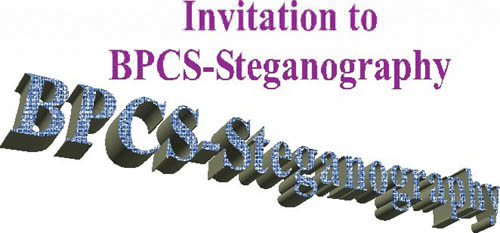

What's Steganography ?
Steganography today
is a computer technique to make confidential information imperceptible
to human eyes by embedding it in some innocent looking "vessel" data (aka "carrier",
"cover" or "dummy" data) such as a digital image or a speech sound.
A typical vessel is a color image having Red, Green, and Blue color components
in a multi-bit data structure. The embedded information can only be extracted
by using a special extracting program and a key, The steganographic technique
we are talking here is definitely different from what is called "file
camouflage" or "file deception" techniques. The general scheme of
steganography is shown in the other page where we will also refer to a file
camouflage technique in brief.
BPCS-Steganography (Bit-Plane Complexity Segmentation Steganography) is a new steganographic technique invented by Eiji Kawaguchi and Richard O. Eason in 1997. It can embed confidential information in vessel data which is typically a true color image (24-bit BMP format) and sometimes in an 8-bit indexed color image. Embedding (actually, replacing) is made on the bit-planes of the image. The most important feature of this steganography is that the embedding capacity is very large. The principle of BPCS-Steganography is explained in the other page.
The objective of this Web page is to show our novel technique to the people who are concerned about the Internet information security. We believe that this page will help increase the number of steganography-interested people in the world.
If you are interested in BPCS-Steganography program, you can use our experimental program Qtech Hide & View which was developed by KIT Steganography Research Group (KIT-STEGROUP). More information is provided in the other page (Qtech Hide & View page). You can view a short (and little old) video to know what the program is like.
If you haven't yet experienced any steganography program, you are invited to try use our program. You will be amazed by Qtech Hide & View because it is so powerful and handy to hide your digital information despite it is secret or not. You can download this program from the Download Page. We prepared stego images (image files that are already embedded with some data) for your extracting experiment. If you have a special message to us (KIT-STEGROUP) about this program, you can send us a formatted message.
We assert ...
Cryptography is a technique to scramble a confidential message to make it unreadable to a third party. It is commonly used in the Internet communications today. Cryptography can hide the content of the message, but it can't hide its presence, i.e., the location of the secret message is obvious. This is the reason why an encrypted message can be targeted by attackers.
Watermarking is another information hiding technique which is used for hiding, actually embedding, some digital evidence, or symbol data, in the valuable digital data such as a photo picture, musical sound, digital movie, etc. The purpose of the watermarking is to protect copyright and/or ownership of the data. In this technique the robustness of the embedded evidence, that can be very small, is the most important. In watermarking the valuable information is the external information that is visible/audible.
Steganography, on the other hand, is a technique to make secret message imperceptible to human eyes by embedding it in some vessel data. We call the visible/audible part of the vessel data "external information", and the embedded data "internal information." The external information is not so valuable for the data owner. Instead, the internal information is very valuable. Such valuable information (i.e., embedded) could be rather fragile than be too robust because the original of the valuable information is kept safe in some place at the owner's side. In steganography the technical requirement is the embedding capacity. The larger the better.
We assert that steganography is the same technique as watermarking in the sense that it hides some information, but very different in objective and technical requirement.
Steganalysis is another research topic about steganography. The objective of steganalysis is to find out a stego-file among the given files. It is a technique to detect a suspicious image/sound file that is embedded with crime-related information. So, it is a topic to make a "sniffer-dog program" to break steganography. However, it is very difficult to make such program that really works. We have a page about this topic
We also have a special embedding page for Qtech Hide & View which allows you to embed secret data more securely and more resistible to steganalysis. That page may be informative to the people who understood the Qtech Hide & View operations in depth.
Possible applications of steganography is described in another page.
Note
BPCS-Steganography is patented in USA (No. 6,473,516). If you are interested in the license of this patent, please write to either of the following persons. Go to the on-line message sending page if you have a quick question.
| Richard O. Eason | Eiji Kawaguchi | |
| 595 Forest Ave, Orono, ME | 8-21-2 Hinosato, Munakata | |
| 04473-3008 USA | Fukuoka, 811-3425 Japan |
(Updated on Feb. 03, 2015 by Eiji Kawaguchi)